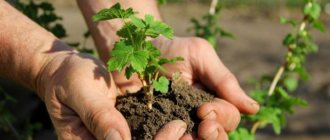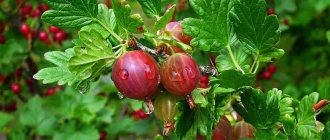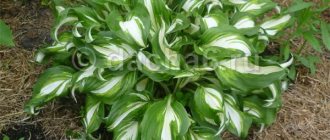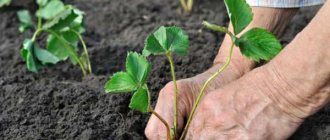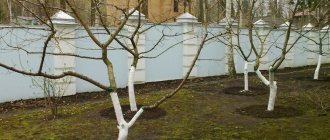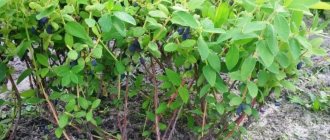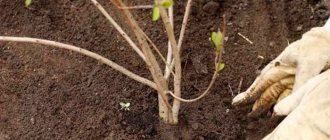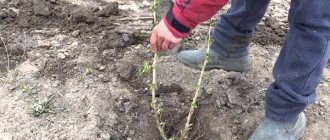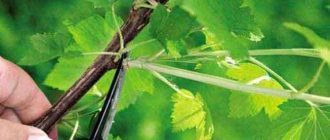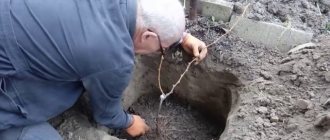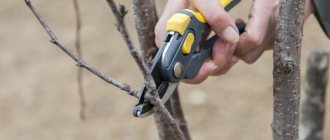Author: Natalya Category: Fruit and berry plants Published: May 15, 2016Republished: February 16, 2019Last edits: November 02, 2020
- How to care in spring
- When to prune
- Reproduction methods
- Diseases and their treatment
- Large varieties
- Beneficial features
Red currant (lat. Ribes rubrum), or garden currant, or common currant , is a deciduous shrub of the Gooseberry family. In nature, red currants grow in the forest zone of Eurasia, forming thickets on the edges of rivers and streams. The Dutch began to grow red currants in culture back in the 5th century, not as a berry bush, but as an ornamental plant. This is why red currants are much more popular in Europe than black currants. Red currants appeared in Muscovy only in the 15th century.
Planting and caring for red currants
- Planting: September or mid to late April.
- Lighting: bright sunlight.
- Soil: slightly acidic or neutral chernozems, forest soils with a high humus content or loams.
- Watering: regular and sufficient, especially during the period of active growth and formation of ovaries (early June), as well as during the period of berry filling (late July or early August). Consumption – 20-30 liters of water per m²: the soil should be saturated to a depth of 30-40 cm.
- Top dressing: in April, urea is added to the soil, in June - slurry or a solution of bird droppings, although the soil can also be fertilized with a mineral complex. In summer, on cloudy days or in the evenings, foliar feeding is carried out on the leaves with solutions of microelements - boric acid, zinc sulfate, copper sulfate, manganese sulfate and ammonium molybdate. In early October, the soil around the bushes is dug up with organic matter, potash and phosphorus fertilizer.
- Pruning: early spring or after leaf fall.
- Reproduction: layering, dividing the bush and cuttings.
- Pests: the plant can be affected by blackcurrant fruit, gooseberry yellow and pale-legged sawflies, currant gall midges, glass midges, bud and spider mites, leaf gall and gooseberry shoot aphids, gooseberry moth, moth and biennial leaf roller.
- Diseases: anthracnose, white spot, European powdery mildew, doubleness (growth, reversion), nectric drying of shoots, striped mosaic, goblet and columnar rust, gray rot.
Read more about growing red currants below.
Preparation of seedlings
The optimal time for planting red currants is the first half of September. However, first you should prepare the seedlings at home. It is recommended to cut woody cuttings at the end of August. The seedling should have 3-4 strong buds. The tip and base of the branch are cut off, and the middle will be used as a future sprout. Its length should not exceed 30 cm. The distance from the lowest bud to the edge is about 15 cm. Seedlings should be installed vertically in pots (boxes). The soil should be loose and slightly moist. Pots with future shoots are placed in a well-lit place. After two weeks, the cuttings will have a root system and can be transferred to the ground. The time of planting red currants directly depends on the growth of shoots indoors. It takes 10 days or more for the root system to mature, so it is recommended to harvest them in advance - at the end of summer.
Botanical description
Red currant bushes reach a height of 1 to 2 m. The root system of red currants is quite powerful. Its shoots are yellowish or gray, the wood is green with a light core. The leaves of red currant are three to five lobed, smooth and shiny on the upper side, and on the lower side a lighter shade and sometimes with pubescence along the veins. Blooming in May, inconspicuous red-brown or yellow-green flowers are collected in clusters. The fruits of red currants are juicy and sour-tasting red berries with a diameter of up to 1 mm, collected in clusters.
Red and black currants are close relatives. White currants and gooseberries are also related to them. In our gardens, red currants are grown as often as black currants, strawberries and raspberries, and much more often than blackberries, blueberries and blueberries that are just beginning to develop in amateur gardens.
Red currants bloom much later than black currants, so they are less likely to suffer from return frosts. It tolerates drought more easily, and with proper care it produces richer harvests. The red currant bush lives for 30-35 years. Almost all varieties of the crop are self-fertile.
- Foxglove: growing from seeds, types and varieties
From this article you will learn how to plant and care for red currants - how and when to water them, what to feed them with, how to prune red currants, how to treat them against diseases and pests, and whether red currants can be grown in areas with a cool climate. In addition, we will give you a description of the varieties of red currants, and you will surely be able to choose excellent varieties for your area.
White currant: planting, care, pruning and propagation
Adding an article to a new collection
White currants are a variety of red currants and are related to black currants and gooseberries. Therefore, agricultural technology and care for these crops are largely similar. However, growing white currants has some peculiarities.
This shrub has three-lobed, serrated leaves of a dark green color. In May, small yellowish-green flowers appear, and in July, spherical fruits of different shades of white and yellow are formed in their place. The taste of white currants is almost the same as that of red ones. At the same time, the fruits do not have a rich aroma, like black currants.
Planting red currants
When to plant
The optimal time for planting red currants is September. If for some reason you were unable to plant red currants in the fall, you can postpone the planting to the spring - to mid or late April.
Since red currants are very light-loving, they need to be grown on a well-lit and ventilated southern slope. The best soils for it are chernozem, forest soils with a high humus content and loams with a neutral or slightly acidic reaction. For planting, choose one- or two-year-old red currant seedlings with an extensive and healthy root system about 20 cm long. Before planting, you need to remove all the leaves from the seedlings and keep their roots in a bucket of water for 2-3 hours.
Planting in autumn
2-3 weeks before autumn planting, dig a hole with a diameter of 50-60 cm and a depth of about 40 cm. Thoroughly mix the soil removed from the hole with 8-10 kg of peat or humus, 200 g of superphosphate and 40 g of wood ash or potassium sulfate - this is the calculation for 1 plant. Pour half of the mixture into the hole and leave the other part nearby. If you are planting several bushes, dig holes for them at a distance of at least 1.5-2 m. When planting red currants along a fence or paths, step back at least one and a half meters from them.
When the soil in the hole settles after 2-3 weeks, lower the roots of the seedling into the hole and straighten them. Place the seedling itself directly or at an angle, deepening the root collar by 5-6 cm to stimulate the formation of additional roots and shoots of renewal. When filling the roots of the seedling with a nutritious earthen mixture, shake it from time to time so that there are no voids left in the roots. When the hole is filled, compact the soil, make a circular furrow around the seedling at a distance of 20 cm and fill it with water several times. After the water is absorbed, mulch the area around the seedling with peat or humus, and cut the shoots at a height of 10-15 cm, leaving no more than 2-3 buds on each - this measure contributes to the formation of a well-branched bush and the development of a strong root system. Before the seedling takes root, it needs to be watered at least twice a week.
Spring planting
Spring planting of red currants is carried out from mid to late April in the same order as autumn, with one exception: holes for seedlings and a fertile mixture are prepared in the fall, but only organic matter is added to the soil, and phosphorus and potassium are added to it before planting.
When to plant currants on a personal plot?
Many novice gardeners wonder when to plant currants? Experts say that this berry crop can be planted both in spring and autumn. At the same time, young seedlings develop equally well, and begin to actively bear fruit after 2-3 years.
When is the best time to plant currant bushes?
Any types and varieties of currants can be planted in the fall. Over the winter, the soil around the young bush will settle and become well compacted. Such bushes grow early in the spring and develop well in a new place.
When planting in autumn, the soil around the young plant should be mulched with fallen leaves, peat, compost or rotted manure. Mulch will retain moisture in the ground and protect young currants from freezing the root system on frosty days.
Most often, young seedlings of this berry crop are planted in September. At the same time, young plants have time to quickly take root.
When to plant currants in the Moscow region? The best time to plant this crop is the end of September - the first half of October. At this time, the kidneys are already entering the resting phase.
How to plant in the fall?
A year before planting currants, add compost or rotted manure to the soil. Before planting, seedlings undergo special treatment. Damaged and dry branches and roots are removed from them. After this, the root system is dipped in a “chatterbox” of clay diluted in water. It will prevent it from drying out.
The planting density of this crop depends on the type and variety. When placing it, the fertility of the soil and the shape of the crown of the bushes are also taken into account. The most spreading and tall varieties are planted less often than more compact currants. The interval between bushes should be 1-1.5 m.
One of the main features of planting young currants is the deepening of the root collar of the seedling 6-9 cm below ground level. In this case, the planting material is placed in an inclined position.
Thanks to this planting method, a spreading bush with a wide base is formed faster. Also, the inclined position of the seedling promotes the formation of additional roots and shoots. If a gardener wants to get a standard currant bush, then the seedling is planted without being buried in a vertical position. In such plants, the regeneration of shoots will be rather weak. Before planting currants, it is necessary to prepare planting holes. Their size should be 40x40 cm or 40x50 cm. Compost or rotted humus is poured into the bottom of the pit. All the roots of the seedlings are straightened. Then they are evenly sprinkled with soil, thoroughly compacting it. It is recommended to shake the seedlings periodically so that it completely fills the voids around the root system of the plant.
After filling the hole 2/3 full, water it abundantly (0.5 buckets per hole). After the planting hole is completely filled and the soil is compacted, the seedling is watered again (0.5 buckets).
After planting all the bushes, the ground around the trunk is mulched with rotted leaves, humus, compost, and peat. This procedure will prevent the formation of a crust and retain the moisture necessary for rapid rooting of currants.
How to plant black currants in spring
In areas where there is little snow in winter, it is better to plant young bushes in early spring.
Planting material purchased in the fall can be buried in the ground. Such seedlings are shaded or pruned short in early spring in order to prevent rapid bud break. Currants are planted in a permanent place after the soil has completely thawed. The best period for planting currants is early April - May. Plants planted later take root worse and are greatly retarded in development. When planting currants in spring, the preparation of holes and the entire process of planting seedlings is carried out as during autumn planting. 2 tbsp are poured into the planting hole. tablespoons of superphosphate and potassium salt (can be replaced with two glasses of crushed wood ash). Compost or humus is poured into the bottom of the hole. Mix the soil with this mass using a shovel. After planting, all branches are cut short, making a cut above healthy buds. Currants are watered every 2-3 days. Beginner gardeners need to know that black currants tolerate spring planting somewhat worse than autumn planting.
How to plant red currants?
The process of planting red and other types of currants is practically no different from planting black currants. Well-lit areas with high soil moisture are chosen for these bushes. Well-drained loams with a slightly acidic reaction are ideal for currants. The distance between red and white currant bushes should be about 1.5 m.
How to plant black currants (video)
glav-dacha.ru
Caring for red currants
How to care in spring
At the end of March, as soon as the weather permits, it is time for sanitary pruning and the formation of red currant bushes. In April, red currants are fed with urea in wet soil, and then, as soon as the top layer of soil dries, they begin to loosen the area around the bushes to a depth of 6-8 cm. If you hilled red currants for the winter, rake the soil away from the bushes. After this, level the surface with a rake and mulch the area with a layer of peat 5-10 cm thick.
If frost returns in May, during the flowering period of red currants, you may have to protect the bushes from them by smoking. At the same time, red currants are examined to identify specimens infected with doubleness (growth) - on such plants the bell-shaped flowers become separate-petaled. If you find single double inflorescences, cut them off, but if the entire bush is damaged, uproot it without delay.
To prevent red currants from becoming thirsty in the spring, keep the soil in the area slightly moist. Remove weeds while loosening the soil, which should be carried out to a depth of 6-8 cm once every two to three weeks. The row spacing is loosened to a depth of 10-12 cm.
What care is needed in summer
In June, red currants are fed with organic fertilizers. In addition to root feeding, the bushes are sprayed with a solution of microfertilizers on the leaves. If you find moth nests, collect them from the bushes and destroy them along with the pest-affected berries. Most likely, this will have to be done several times.
When the time comes to harvest, collect red currants as they ripen in whole clusters in small trays or boxes in which the fruits will not be crushed. After harvesting, currants require mandatory watering followed by loosening.
Autumn care
At the beginning of autumn, you can start vegetative propagation of red currants. At the end of September or a little later, organic and mineral fertilizers are added to the pre-moistened soil in the area with red currants, after which the soil is dug up to incorporate them.
After leaf fall, the currants are pruned, and if the autumn is dry, winter watering of the area is carried out.
- Coriander: cultivation, properties, application
Processing red currants
At the beginning of March, red currant bushes need to be awakened from winter sleep - watered with water heated to 80 ºC from a watering can. After this, on the still dormant buds, preventive treatment of the bushes against diseases is carried out with copper sulfate or Nitrafen. The next preventive treatment of red currants against fungal diseases with the same drugs is carried out 10 days after harvesting.
During the budding period, for preventive purposes, red currants are treated against insect pests with Actellik, Karbofos or Rovikurt. Repeated processing is carried out after harvesting.
Watering
Despite the fact that red currants, due to their well-developed root system, are much more tolerant of dry conditions than black currants, a lack of water retards their growth, and during the period of fruit formation and filling, it often leads to their crushing and even shedding. Therefore, regular and sufficient watering of red currants during the period of active growth and formation of ovaries, that is, in early June, as well as in late July and early August, when the berries are full, becomes especially important.
Watering is carried out at the rate of 20-30 liters per m² of area in order to saturate the soil to a depth of 30-40 cm. Water is poured into circular grooves 10-15 cm deep, made at a distance of 30-40 cm from the bush. You can arrange an irrigation area around each bush, fencing it with an earthen roller 15 cm high. When the well-moistened soil dries, loosen the area so that a crust does not form on its surface. If in the spring you took the trouble to mulch the ground on your site with humus, decomposed peat or rotted manure at the rate of 10-15 kg per bush, you will have to water the site and loosen it much less often.
Top dressing
In April, urea is added to the moistened soil at the site for embedding at the rate of 10-15 g per m². In June, red currants are fed with 1 liter of slurry infusion diluted in a bucket of water or a solution of half a liter of bird droppings infusion in 10 liters of water. If you can’t find organic matter, add 10-15 g of urea, the same amount of potassium sulfate and 20 g of superphosphate under each bush.
In summer, red currants need foliar feeding with microelements. To do this, in 10 liters of water you need to dissolve up to 2.5 g of boric acid, 5-10 g of manganese sulfate, 1-2 g of copper sulfate, 2-3 g of ammonium molybdate and the same amount of zinc sulfate. Processing red currants by leaves is carried out on a cloudy day or in the evening.
At the beginning of October, red currants are fed for the last time: 10-15 kg of organic fertilizer, 100 g of superphosphate and 50 g of potassium chloride are added to each bush for digging. Mineral fertilizers can be replaced with garden or fruit and berry mixture at the rate of 500 g per bush.
Care after landing at a new place
The first time after planting, buried currants require special attention:
- In order for water and air to freely penetrate to the roots, it is necessary to periodically loosen the soil. At the base of the bush, loosening is carried out to a depth of 7 cm, in the remote area - to 15 cm.
- For the first 12-14 days, water the plant every other day so that the soil is saturated with moisture to a depth of 58 cm. On average, three buckets should be used per root.
To prevent the bush from being damaged by frost, it is insulated for the winter. The tree trunk area is cleared of leaves and other debris. Then the soil is mulched with peat or straw and covered with pine branches. It is better to gather the branches together and tie them with twine. When snow falls, a snowdrift is thrown around the bush.
Pruning red currants
When to prune
Growing red currants involves regular formative, rejuvenating and sanitary pruning of bushes. Red currants are pruned in early spring or late autumn, when they are dormant.
The structure of red currant is similar to that of black currant, but its fruiting shoots last twice as long. Fruit buds of red currants almost always form on the tops of annual shoots, and its fruits are located in the upper part of the branches, so when pruning, the tips should never be cut off. Since the fruiting period of red currant shoots is longer than that of black currant shoots, its anti-aging pruning is not done so often.
Pruning in spring
In a one-year-old redcurrant seedling, all shoots are shortened by half to the outer bud, forming a compact spherical bush. Since red currant is a very light-loving plant and when the bush thickens, it sharply loses productivity, its bush is formed for 5-6 years from no more than 15-20 branches, and from the seventh year, in addition to sanitary pruning, which involves the removal of unnecessary, diseased, broken or dried branches, it will be necessary to carry out rejuvenation - remove branches that have expired and regulate the growth of zero shoots.
Of the zero shoots, the most developed and well-located ones are left for renewal, that is, those that grow closer to the bush, do not lie on the ground and do not intersect with other shoots. They are shortened by half the length to the outer bud pointing upward, and the remaining growths are cut out.
Autumn pruning
In the autumn, after leaf fall, when the red currants bear fruit and enter a dormant period, the bushes are sanitized: branches that are broken, diseased, dried out or growing in the wrong direction are removed. If for some reason you did not carry out formative pruning of the bush in the spring, you can do it in the fall.
Transplant timing
You can replant an adult bush in spring, autumn and even summer. Thus, this can be done when it is convenient for the gardener, but, nevertheless, temperature indicators and weather must be taken into account. They affect the degree of survival of the plant in a new place.
in spring
Like young seedlings, in the spring currant bushes should be replanted the earlier the better, but even before the sap begins to flow and the buds open. In the Middle Zone this is approximately the 2nd half of March - 1st half of April. If the buds have already bloomed, the shrub will take root worse. After replanting the currant, it most likely will not bear fruit in the first year, since it will have to grow new roots.
In summer
Currants are not replanted in summer unless absolutely necessary. At this time, it has the lowest chances of rooting, since it spends all its energy on the growth of greenery and fruits, and the high temperature does not promote survival.
But if you cannot do without replanting, for example, if the soil is contaminated, then this can be done in the summer. In order for the bush to take root better, it must be dug up with a large lump of earth and not expose the roots. It must be replanted immediately into a previously prepared hole.
in autumn
Autumn transplantation has a number of advantages and is therefore preferable. After the end of the growing season, sap flow stops, the plant tissues are saturated with nutrients, the roots adapt faster and produce new shoots, so it is best to replant currants in the fall.
The timing of autumn replanting is after all the foliage has fallen from the bush, approximately in the 2nd half of September or October. In this case, you need to be in time before a steady cold snap: the bush must be given time to take root, so it needs to be replanted at least a month before the onset of frost. If this is done later, the plant may freeze in extreme cold. When replanting a currant bush in the fall to a new place, it will bear fruit in the next season.
Propagation of red currants
Reproduction methods
You, of course, can buy red currant seedlings at any market, but there is no guarantee that they will sell you exactly the varieties that you decide to buy. If you don't want to experience disappointment, do the breeding yourself. Red currants are propagated vegetatively - by layering, cuttings and dividing the bush.
Reproduction by layering
This is the simplest and most effective way to propagate a crop. For it, choose a young bush of three, four or five years old, in early spring they loosen the soil under it, fertilize it, make grooves in the soil 8-10 cm deep, running from the center of the bush, place well-developed one- or two-year-old shoots in them, securely fix them them in several places with metal hooks and cover the middle part of the layering with soil so that their top remains on the surface. When the shoots developing on the layering reach a height of 10-12 cm, they are spudded twice with an interval of 2-3 weeks with moist, loose soil. Throughout the summer, the cuttings are watered abundantly, mulching the area around them with organic matter.
- Yarrow: properties, planting and care, types and varieties
In the fall, the rooted and sprouting cuttings are separated from the mother plant and, dividing them along the length into separate plants with a root system, they are transplanted to a permanent place. In two to three years, the most developed of them will already begin to bear fruit.
Propagation by cuttings
Cuttings are also a reliable method of propagation. Lignified red currant cuttings from one-year-old shoots grown from the root or on two- to three-year-old branches take root more easily and quickly. The thickness of the cuttings should be at least 8 mm, and the length should be 18-20 cm. Planting material is prepared in the fall, after which the cuttings are placed in a box with wet sand to form root primordia and kept for 2.5-3 months at a temperature of 2-3 ºC, and then placed under the snow or in the vegetable drawer of the refrigerator until spring planting.
The cuttings are planted in open ground in early spring at an angle at a distance of 20 cm from each other under plastic bottles or glass jars. The depth of immersion of the cutting into the soil is as follows: only two buds should remain above the ground, and the rest are immersed in the soil. The soil around the cuttings is compacted and watered, and when it dries, the area is mulched with humus or fine peat. Rooted cuttings are transplanted to a permanent place in September.
Currants can also be propagated by green cuttings, but they take too long to form the root system to the detriment of the ground part, so they are planted in a permanent place no earlier than a year later, and, therefore, they begin to bear fruit later than red currants from lignified cuttings.
Dividing the bush
Usually this method of propagation is resorted to when there is a need to transplant the currant bush to another place. First, all diseased, old and broken branches are removed from the bush, after which the bush is dug up, divided into parts with a sharp sterile instrument, each of which should have well-developed roots and shoots, then the cuts are treated with crushed coal and the sections are planted in prepared holes for 5- 7 cm deeper than the mother bush grew. After planting, the shoots are shortened to 15-20 cm, watered generously and the soil continues to be moistened daily until parts of the bush take root in the new location.
Choosing the ideal place
Transplanting currants is a process that does not take much time to complete. Most of the time and effort goes into finding a place where bushes with berries will grow. Did you choose something bad? You can forget about a rich harvest, so let's look at the main secrets of the ideal place for currants.
- Avoid dark places. Remember, currants love the sun and if there is little sunlight, the bush will not produce the proper harvest, and will also often suffer from pests and all kinds of diseases. In particular, fungal diseases such as brown spot may appear. It is best to place the bushes in such a way that all the vegetative mass is outside and not inside.
- The soil should not be too wet. Transplanting currants to a new location is an extremely sensitive undertaking, in which it is important to maintain soil moisture. If the root system is constantly in a damp place, it will quickly rot. Choose moderately moist soil.
- It is better not to plant anything next to currants. The foliage of the shrub is susceptible to fungal diseases that can be transmitted from other crops. We do not recommend creating compositions with other plants.
- Transplantation of currant bushes can be carried out in sandy soil. In such soil the bush will quickly develop and will delight you with a rich harvest. To do this, you need to dig a small hole, pour 5 cm of crushed stone and 15 cm of sand into it.
Pests and diseases of red currant
Diseases and their treatment
Red currant diseases are typical for all Gooseberries. On our website there is an article “Diseases and pests of gooseberries”, which describes in detail all the dangers that await representatives of this family, so we will not dwell in detail on each disease, but will simply remind you of them.
Pests and diseases of currants - control and prevention
So, red currants are affected by anthracnose, white spot, European powdery mildew, doubleness (growth, reversion), nectrium drying of shoots, striped mosaic, goblet and columnar rust, gray rot. In the fight against fungal diseases, good results have been shown by such fungicides as Bordeaux mixture, Captan, Homitsin, Fthalan, Topsin M, Fundazol, colloidal sulfur, Cuprozan and other drugs with a similar effect. And viral diseases such as terry and mosaic, unfortunately, cannot be cured by any medicine. If the virus has infected only individual branches or inflorescences, cut them out and burn them, but if the entire bush is infected, you will have to get rid of it.
Pests and their control
Just like black, white currants and gooseberries, red currant bushes can be affected by blackcurrant fruit, gooseberry yellow and pale-legged sawflies, currant gall midges, glass midges, bud and spider mites, leaf gall and gooseberry shoot aphids, gooseberry moth, moth and biennial leaf roller.
The best insecticides today are Actellik, Karbofos and Rovikurt. Aktara, Metaphos, Etafos Ambush, Phosfamide, Vofatox, Tedion, Tsidial, Zolon, Antio and others also showed good results in pest control.
We would like to remind you that mostly weakened and unkempt plants are affected by disease or insects, so the main protection against diseases and pests is compliance with cultural practices and timely care. And, of course, preventative treatment of bushes in early spring and after fruiting will not hurt.
Varieties of red currants
Red currants are popular all over the world. Currants are grown on an industrial scale in the USA, the Netherlands, the Czech Republic, Slovakia, Poland, Germany, Great Britain, Latvia and Estonia. The demand for the culture is caused not only by its taste, but also by the valuable medicinal properties that it possesses. We offer you an introduction to the most popular varieties of red currants.
Large varieties
Large-fruited currants are represented by the following varieties:
- Viksne is a large, sweet red currant of Latvian selection of early ripening with berries of a dark cherry color and a sweet and sour taste. Viksne is a winter-hardy and drought-resistant variety, almost not affected by diseases and pests. The yield from one bush is 5-7 kg;
- Ural beauty is a high-yielding and winter-hardy self-fertile variety with large red berries of a sweet dessert taste weighing up to 1.7 g. The variety is not damaged by sawflies and moths, it is also resistant to powdery mildew;
- Fertodi is a self-fertile, productive, winter-hardy and fungus-resistant variety of Hungarian selection with round, bright red berries weighing up to 1.2 g with a pleasant sweet and sour taste;
- Darnitsa is a large red currant, the weight of the berries reaches 1.5 g. The variety has a medium ripening period, drought- and frost-resistant, high-yielding, rarely affected by diseases. The shiny, dark red berries are used both for fresh consumption and for freezing and processing;
- Rondom is a high-yielding, anthracnose-resistant, frost-resistant late variety of Dutch selection with large berries of sweet and sour taste, ripening on low compact bushes.
The varieties Asora, Obsky Zakat, and Ilyinka are also distinguished by their large fruits.
Sweet varieties
The most famous sweet varieties are:
- Sugar - aromatic, tasty and sweet red currants that can be eaten straight from the bush. However, the variety is characterized by low self-fertility, and for good fruiting it needs pollinators - for example, red currant variety Natalie;
- Red Cross is a medium-ripening variety with large light red berries with a dessert taste, becoming smaller towards the end of the cluster. Unfortunately, the variety is affected by anthracnose;
- Early sweet - a winter-hardy, productive variety, demanding care and soil fertility, with medium-sized sweet light red berries of equal size;
- Svetlana is a winter-hardy and productive variety of medium ripening with small round berries of light red color with thin skin;
- Houghton's Castle is a Western European winter-hardy and productive variety with medium-sized red berries and a pleasant taste.
Early varieties of red currants
Early ripening red currant varieties include:
- Victoria is a high-yielding variety of European origin with medium-sized berries of good taste, consumed fresh and suitable for processing;
- Crystal - self-fertile variety with yellowish round berries with transparent skin, good balanced taste, medium or large size;
- Firstborn is a frost-resistant, high-yielding and mycoses-resistant red currant of Finnish selection, from the bush of which you can pick up to 10 kg of sweet and sour, medium-sized, pleasant-tasting berries. The variety is a universal pollinator for self-sterile varieties;
- Serpentine is a high-yielding variety resistant to diseases and pests with large sweet and sour berries located on long clusters;
- Generous - resistant to anthracnose and bud mites, high-yielding and winter-hardy red currant with light red, moderately sour berries.
Famous early varieties of red currants are also Dutch red, Early sweet, Laturnais, Chulkovskaya, Rachnovskaya and Konstantinovskaya.
Mid-season
There are many more varieties of red currants of medium ripening than early or late ones. The most commonly grown of these are:
- Versailles Red - a productive large-fruited and self-fertile variety with large red berries with dense skin, consumed both fresh and processed;
- Rose is a disease-resistant dessert variety with medium-sized pink one-dimensional berries, a delicate sweet taste with a slight sourness;
- Buzhanskaya is a Ukrainian high-yielding and mycoses-resistant variety with bright red large berries weighing up to 1 g, suitable for both fresh consumption and freezing and processing;
- Gazelle is a high-yielding winter-hardy and fungus-resistant variety with small but very tasty red berries;
- Red Andreichenko is a self-fertile, winter-hardy, high-yielding variety, resistant to fungal diseases, with red round berries weighing up to 0.8 g with a pleasant sweet and sour taste.
In addition to those described, there are other mid-season varieties of red currants that are popular in amateur gardening: Purple, Hero, Gonduin, Reibey Castle, Star of the North, Natalie, Polyana, Samburskaya, Vika, Niva, Beloved and others.
Late varieties
Among late-ripening varieties, the most commonly cultivated varieties are:
- Valentinovka is a winter-hardy, high-yielding self-fertile variety, resistant to powdery mildew, with medium-sized, one-dimensional berries with a sour taste and high gelling properties;
- Marmeladnitsa is a winter-hardy, productive, and resistant to anthracnose and powdery mildew variety of very late ripening with orange-red berries of sour taste, medium or large size;
- Osipovskaya is a winter-hardy, productive and disease-resistant variety of Russian selection with dark red berries of equal size and good taste;
- Dutch red is a hardy, unpretentious, winter-hardy, productive and anthracnose-resistant variety of Dutch selection with medium-sized red berries of sweet and sour taste with transparent skin;
- Lapland is a winter-hardy, productive self-fertile variety with light red berries of medium and small size and an excellent, delicate sweet and sour taste.
In addition to those mentioned, late-ripening varieties Dana, Ogonyok, Orlovskaya Zvezda, Pamyatnaya, Orlovchanka, Rosita, Gift of Summer, Ural Dawns and others are grown in cultivation.
The best varieties of red currants
Taking into account such criteria as the size of the berries, their taste, the amount of vitamins and sugars they contain, as well as the degree of their winter hardiness, the best varieties of red currants can be considered Viksne, Dutch Red, Cascade, Ural Beauty and Serpentine.
Varieties for the Moscow region
Red currants are one of the most winter-hardy berry crops, and they can be successfully grown in areas with a cool climate. Red currants for the Moscow region should have precisely the same quality as winter hardiness. What varieties can we recommend for cultivation in the Moscow region? The best red currant, in addition to winter hardiness, should have other advantages - a fairly large size, a high content of vitamin C and sugars, good taste and, preferably, aroma. Varieties with the listed qualities include the following:
- Asya is a mid-early, high-yielding and disease-resistant variety with medium-sized dark red berries with a sweet and sour taste;
- Natalie is a productive, self-fertile and winter-hardy variety, highly resistant to diseases and pests. The berries of this variety are large, round, deep red in color and have a sweet and sour taste;
- Jonker van Tets is a winter-hardy, productive, disease-resistant, self-fertile and early-ripening variety with round or almost pear-shaped large bright red berries of pleasant taste;
- Rachnovskaya is a high-yielding, winter-hardy, self-fertile variety, resistant to diseases and pests. The currant berries of this variety are medium-sized, red, sweet and sour;
- Nadezhda is an early, high-yielding, winter-hardy, self-fertile variety, resistant to pests and diseases, with round, medium-sized purple-red berries, sweet and sour taste and universal purpose.
Properties of red currant - harm and benefit
Beneficial features
Red currant berries are rich in vitamins A, C, E, potassium, iron and selenium, malic and succinic acid, nitrogenous and pectin substances. They contain many antioxidants that can fight cancer cells. What makes red currant beneficial for humans is primarily the high content of provitamin A in its berries, which is necessary for healthy hair, skin and bones, and also prevents aging.
The presence of a unique substance, oxycoumarin, in red currants ensures the prevention of heart attacks and has a positive effect on the activity of the cardiovascular system. People suffering from atherosclerosis are advised to consume red currants daily because of the pectins they contain, which remove excess cholesterol and thereby prevent the formation of plaques in the blood vessels.
In addition, red currant improves the functioning of the stomach and intestines, increases sweating, which helps remove excess salts, waste and toxins from the body. It has anti-inflammatory, choleretic, antipyretic, hemostatic, cleansing and laxative properties.
When consumed regularly, red currant juice normalizes the level of hemoglobin in the blood, relieves constipation and uric acid salts, and helps pregnant women fight the symptoms of toxicosis - nausea and vomiting. The juice helps athletes maintain tone and restore strength after competitions. Drinking juice reduces fever during fevers in children and adults. It is also indicated for anemia, diabetes, loss of strength and chronic fatigue.
Planting and caring for currants - how to grow them in the garden
Compared to many other berries and fruits that are beneficial to the body, red currant is a product that does not cause allergies - it is prescribed even for dermatitis.
Contraindications
But, despite such obvious benefits of red currants, we cannot remain silent about the fact that it can cause harm to some people. These categories include patients with stomach and duodenal ulcers, acute gastritis, hepatitis, and hemophilia. Regular consumption of red currants is not advisable for people with increased blood clotting.
